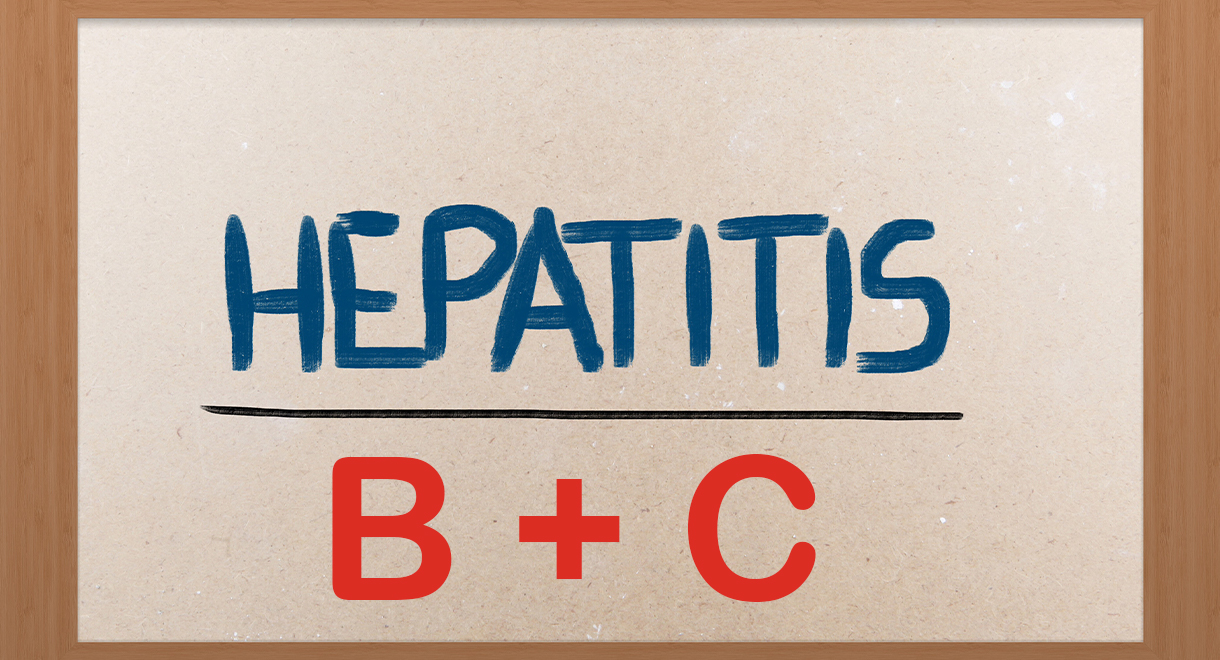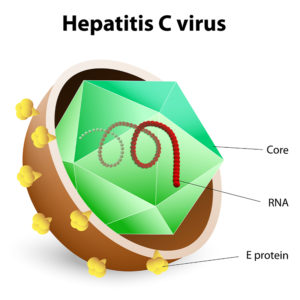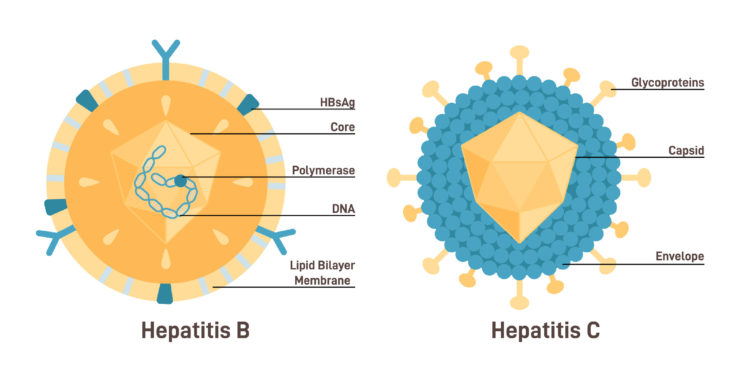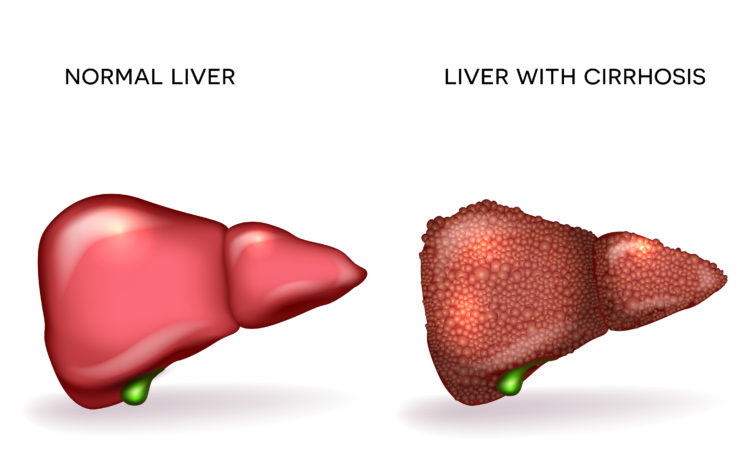

Hepatitis B and C
Hepatitis caused by the hepatitis C virus.
It is estimated that 170 million people worldwide are infected with the hepatitis C virus.

March 2021 was the five-year anniversary of the introduction of curative drug treatments for the hepatitis C virus. These drugs known as direct-acting antivirals (DAAs), have changed the course of history for hepatitis C sufferers bringing tremendous physical and emotional relief.
We have come a long way with these drugs providing a greater than 90% cure rate, but we cannot afford to get complacent.
It is vital that people are aware of the way hepatitis C can be transmitted, how easy it is to be tested for hepatitis C infection, and the importance to get early treatment.
How to reduce the risk of hepatitis C transmission
- Never share or re-use injecting equipment such as needles, tourniquets, spoons, swabs, water, or any other equipment. Ninety percent of new infections occur this way.
- Wash your hands in hot soapy water before and straight after injecting or use new alcohol swabs if you cannot do this.
- Dispose of sharps and injecting equipment in an approved disposal container (this is supplied by your needle and syringe program).
Treatment with direct-acting antiviral drugs is effective and safe and results in viral clearance from the body (known as a sustained virological response [SVR] in the vast majority of patients.
A SVR usually lasts a lifetime and produces a reduction of hepatitis C related liver diseases and risk of death. However, it is good not to get complacent, as after treatment with these drugs some patients may still have a major risk of progressive liver damage; this can lead to liver cirrhosis, liver failure and liver (hepatocellular) cancer. This is the result of ongoing chronic inflammation in the liver.
Modern Antiviral Drugs to Treat Hep C in 2023
Direct-Acting Antiviral Hepatitis C Medications
Many studies have shown that direct-acting antiviral (DAA) drugs can effectively remove the hepatitis C virus (HCV) from your body more than 90% of the time.
Direct-acting antivirals are medications that act to stop the hepatitis C virus replicating. The duration of treatment with DAA medicines varies in length from 8 to 24 weeks. These drugs are taken orally.
First-line direct-acting antiviral medications that offer a combination approach to treatment include:
- ledipasvir-sofosbuvir (Harvoni)
- elbasvir-grazoprevir (Zepatier)
- sofosbuvir-velpatasvir (Epclusa)
- sofosbuvir-velpatasvir-voxilaprevir (Vosevi)
- glecaprevir-pibrentasvir (Mavyret)
Interferon-Based Hepatitis C Therapies
Another medication option for treating hepatitis C is interferon (IFN) which is given via a weekly injection. Interferon is injected into areas of your body with a layer of fat between the skin and muscle, such as your thigh, the outer surface of your upper arms, your stomach, or your buttocks.
Interferon treatment is given for around 48 weeks and can cause more adverse side effects than those experienced with oral DAA drugs. Many patients quit interferon treatment early because of side effects.

Despite this, there may be times when interferon therapy is recommended. Studies have found that IFN-based therapy is less likely to reactivate the hepatitis B virus in patients who also have hepatitis B as well as hepatitis C when compared to those receiving oral DAA-based treatment.
Hepatitis B Infection
Chronic hepatitis B (CHB) infection is a major public health problem worldwide, with around 400 million people affected. Patients with CHB have a 15% to 40% chance of developing cirrhosis, liver failure and liver (hepatocellular) cancer in their lifetime. The risk of having liver cancer is increased by more than 100–200 fold compared to non-infected people. Currently two classes of drugs are available for the treatment of chronic hepatitis B. These are pegylated interferon and nucleoside/nucleotide analogues (known as NAs).
Interferon has been superseded by the growing success of nucleoside/nucleotide analogues (NAs). However, viral resistance to NA drugs is a problem. Newer NAs, such as entecavir and tenofovir, have very low viral resistance rates and good safety profiles. Long-term use of these agents can effectively suppress hepatitis B virus DNA, leading to a decrease in liver inflammation flares, as well as in the development of cirrhosis and liver cancer.
Current treatment strategy of chronic hepatitis B is to achieve prolonged and effective viral suppression. Unlike treatment for hepatitis C, the drugs used in hepatitis B do not eradicate or totally kill the hepatitis B virus.
There is a chance of viral rebound if NA drugs are stopped even when the serum HBV DNA levels have declined to levels below the detectable limits of PCR testing.
With the availability of entecavir and more recently tenofovir, prolonged effective suppression of the hepatitis B virus can be achieved with long-term treatment. It is likely that the complications with CHB including cirrhosis and liver cancer will decrease in the future with these newer drugs.
However, more studies on the safety profiles and efficacy on long term use of these newer agents are required.
A safe and effective vaccine that offers 98% protection against hepatitis B infection is available. Preventing hepatitis B infection prevents the development of complications including chronic liver disease and liver cancer.

Nutritional medicine for hepatitis
The DAA drugs and Interferon are designed to eradicate the virus, but they do NOT directly repair liver damage caused by the hepatitis C or B viruses.
Being overweight and having a fatty liver will enable the hepatitis C virus to damage your liver more. A low carbohydrate diet high in protein and vegetables is beneficial. To see details of the best diet for a fatty liver watch my video series on the liver HERE.
To reduce liver inflammation and the development of such severe liver diseases we recommend the following-

- Keep your weight in the healthy range
- Avoid excess alcohol
- Avoid getting a fatty liver
- Avoid overuse of acetaminophen and other potentially liver toxic drugs
Supplements to help liver repair are:
Livatone Plus which contains the clinically proven dose of milk thistle combined with selenium, antioxidants, activated B vitamins, NAC and glutathione. It is the most comprehensive liver formula available and has been tested in a clinical study of patients with liver inflammation caused by fatty liver. Livatone Plus contains the mineral selenium which has proven anti-viral and anti-cancer effects and reduces viral replication.
A study showed that the serum selenium concentration in hepatitis B and C patients is less than serum selenium concentration of healthy individuals.
Hepatitis C viral infection is linked with low blood levels of antioxidants, including selenium and elevated level of oxidative stress. Four-year animal studies showed that a nutritional supplement of selenium decreased the hepatitis B virus (HBV) infection by 77.2%.
The results indicate that the serum selenium concentration in hepatitis B and C patients is less than the serum selenium concentration in healthy individuals. Serum selenium decline is relative to the severity of disease. Based on findings of this study, it is proposed that selenium should be supplemented in such patients to optimize nutritional support and to get a better treatment response. A controlled clinical trial has found that selenium can effectively reduce the viral load in HIV infection.
Extra NAC (N-Acetyl-Cysteine) may be beneficial to boost glutathione levels. Glutathione cleanses the liver and reduces liver inflammation. It is important to keep looking after your liver even if the DAA drugs have eradicated the virus, as this can reduce the risk of cirrhosis and liver cancer.
Raw juicing
Dr Cabot has known about the incredible healing power of raw juices from a very young age. Her grandmother’s life was saved by raw juicing back in the 1930s. The fresh raw vegetable juices are vitally important. It is good to use both whole fruits and vegetables in the diet as well as the juices, as the juices provide an easily absorbable form of nutraceuticals that are very beneficial for the liver. Juices made freshly from raw fruits and or vegetables have unique healing and rejuvenating properties.
For those who feel they need an extra boost there is nothing better than having a raw juice every day. It will brighten up the day by providing extra energy and endurance. Juices are unique because they allow the gut to receive very concentrated amounts of phyto-nutrients that could not be obtained by eating a normal amount of raw vegetables and fruits. Juices are high in vitamin C, bioflavonoids, carotenoids, living plant enzymes to aid digestion and vitamin K in green leafy vegetables.
Appropriate juice recipes found in “Raw Juices Can Save Your Life” book. Recommended juices are:
Liver Tonic Juice
Ingredients
- 1 carrot
- 1 lime or lemon
- ¼ to ½ of a beet
- 4.5 oz (125 g) cucumber - leave skin on
- 1 orange
- 2 dandelion or 2 cabbage leaves
Method
- Wash, trim and chop all ingredients and process in juicer. Drink 2 to 3 small cups daily.
Liver Cleansing Juice
Ingredients
- 2 dandelion leaves or 2 spinach leaves or 2 large cabbage leaves
- 1/2 cup broccoli florets
- 1/4 cauliflower or 2 large Brussels sprouts
- 1 clove garlic or 1 small radish (optional)
- 1/2 cup parsley
- 1 apple, whole
- 1 lime or 1 lemon
Method
- Wash, trim and chop produce and process through juicer. This juice is high in Vitamin C and sulfur compounds to cleanse the liver.
- Drink 8 to 16 oz (250 to 500 ml) daily.
Options
This is a very strong mixture and may be diluted 1 part juice to 1 part water or you can dilute it with cold herbal or fruit flavored tea. You may sweeten this juice by adding the following - strawberries, carrot and a small amount of beetroot.
Antibiotic Juice Recipe
This juice combination acts as a powerful antibiotic and antiseptic, and when taken regularly can fight infections directly. One glass (at least 300 to 400 mls / 10 - 13 oz) must be taken every day, and in more severe cases, twice daily.
Ingredients
- 1 carrot
- 1 beetroot including some green tops
- 2 spinach leaves
- 1 to 2 apples - skin on
- 0.4 inches (1 cm) fresh ginger
- 1 inch (2.5 cm) horseradish root
- 1/2 to 1 clove garlic (optional) or 1/2 red onion
- 1/2 cup watercress (optional)
- 2 limes or 2 lemons
Method
- Wash all ingredients, trim, chop, and put through juicer.
- Dilute with water or cold herbal tea to begin with, or if too pungent.
NOTE: Some green herbs exert natural antibiotic properties and can be added in small amounts to your juice recipes. The most effective ones are thyme, oregano, coriander and basil.
Options
If you prefer this juice to be sweeter, add more apples, or 1 orange, or 1 slice of watermelon.
References
The Possible Role of Selenium Concentration in Hepatitis B and C Patients Saudi J Gastroenterol. 2012 Mar-Apr; 18(2): 106–110. doi: 10.4103/1319-3767.93811
Buljevac M, et al,. Serum selenium concentration in patients with liver cirrhosis and hepatocellular carcinoma. Acta Med Croatica. 1996;50:11–[PubMed] [Google Scholar]
Whagner PD. Metabolism of selenium in humans. J Trace Elem Exp Med. 1998;11:227–40.
Suppression of Human Immunodeficiency Virus Type 1 Viral Load With Selenium Supplementation. A Randomized Controlled Trial
Barry E. Hurwitz, PhD et al,
Arch Intern Med. 2007;167(2):148-154. doi:10.1001/archinte.167.2.148
Efficacy of Berberine in Patients with Type 2 Diabetes
Published in final edited form as:
Metabolism. 2008 May; 57(5): 712–717.
doi: 10.1016/j.metabol.2008.01.013
Dennis, B., et al, (2021, August 07). New Hope for Hepatitis C Virus: Summary of Global Epidemiologic Changes and Novel Innovations Over 20 Years. World Journal of Gastroenterology. doi:10.37489wjg.v27.i29.4818
Baumert, T., et al. (2019, January). Status of Direct-Acting Antiviral Therapy for Hepatitis C Virus Infection and Remaining Challenges. Gastroenterology. doi:10.1053/j.gastro.2018.10.024
Geddawy, A., et al. (2017, March). Direct Acting Anti-Hepatitis C Virus Drugs: Clinical Pharmacology and Future Direction. Journal of Translational Internal Medicine. doi:10.1515/jtim-2017-0007
U.S. Department of Veterans Affairs. (2019, October 03). Classification of Direct-Acting Antiviral Agents in HCV Treatment Regimens. Retrieved January 09, 2023, from https://www.hepatitis.va.gov/hcv/treatment/hcv-daa-class.asp
Pockros, P. (2013, October). Interferon-Free Regimens and Direct-Acting Antiviral Agents. Gastroenterology & Hepatology. Retrieved January 09, 2023, from https://www.ncbi.nlm.nih.gov/pmc/articles/PMC3992059/
Jian, X., Ye, J., Li, Y., Li, L. (2018, July 28). Hepatitis B Reactivation in Patients Receiving Direct-Acting Antiviral Therapy or Interferon-Based Therapy for Hepatitis C: A systematic Review and Meta-Analysis. World Journal of Gastroenterology. doi:10.3748/wjg.v24.i28.3181
Know someone who might benefit from this article? Share it!
Need Help?
1-888-75-LIVER
Monday to Friday, 9:00 am to 5:00 pm MST
100%
Satisfaction Guaranteed
If it’s faulty or wrongly described, we’ll replace it.










